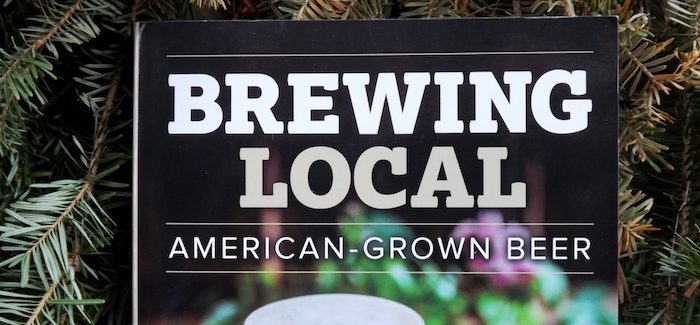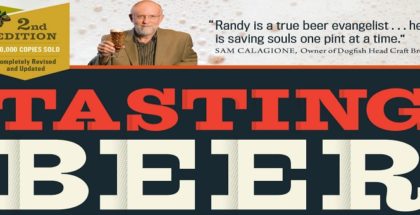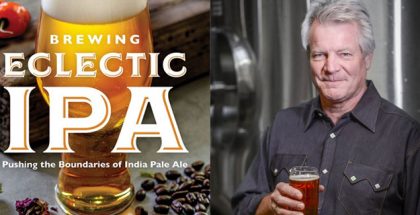Book Review & Interview | Brewing Local

- David Nilsen
- On April 16, 2018
- http://davidnilsenbeer.com
- FacebookTwitterInstagramLinkedIn
For beer writer and historian Stan Hieronymus, brewing local means more than just using attention-grabbing, wild ingredients like dandelions and tree bark; it means looking at the complete agricultural picture of a region as it relates to beer. That certainly includes those aforementioned esoteric additions but also encompasses workhorse fermentables like corn and rice, which were looked down upon in craft circles until recently.
Brewing Local: American-Grown Beer by Stan Hieronymus (Brewers Publication, 2016)

In Brewing Local, Hieronymus looks back at the history of American-grown brewing ingredients and traces their usage from early colonial times through the modern day. This involves a well-researched history of the use of corn in brewing, as well as an extensive look at the current trend toward using gardened and foraged botanical ingredients to either augment traditional recipes or to create gruit-style concoctions.
Along the way, Hieronymus talks to leaders in the local beer movement, including the folks at Scratch Brewing, Fonta Flora Brewery, Fullsteam Brewery, and others. He provides extensive information on cultivating or foraging for wild ingredients, and the book concludes with nearly two dozen homebrewing recipes from brewers who work with these ingredients.
Homebrewers seeking practical guidance and connoisseurs looking to expand their knowledge will both appreciate the author’s conversational tone in relating a wealth of information, a skill familiar to readers who have learned from Hieronymus’ previous brewing books—For the Love of Hops, Brew Like a Monk, and Brew with Wheat.
I recently spoke with Stan about Brewing Local, homebrewing with weird ingredients, and the importance of knowing where our beer comes from.
PorchDrinking: In your introduction to Brewing Local, you talk about the small-scale brewing scene in the U.S. as a renaissance rather than a revolution. Can you expound on that as it pertains specifically to the use of local, even foraged ingredients?
Stan Hieronymus: I suggested that what is going on is a renaissance for two reasons. First, we were drinking local beers long before we had nationally distributed beers that morphed into a commodity. Second, beer is always changing and what is occurring now is a natural extension of that rather than a revolution. And we’re talking about everything from New England IPAs to fruited Goses to beet beers to foraged beers.

You’ve written technical, brewer-minded books about specific beer ingredients, as well as Brew Like a Monk, a book that is probably the go-to text for folks wanting to brew Belgian abbey styles. What made you decide to write Brewing Local, and how did this idea develop? Tell me a little about the vision for the book.
There’s certainly a line that runs directly from Brew Like a Monk to Brewing Local. I started my blog and called it Appellation Beer because I began thinking more about the importance of place after visiting the monastery breweries. Beerfromaplace.com seemed like too long a URL and beerterroir.com, a domain name I also bought at the time and owned until recently, seemed too bulky or confusing.
Research and travel for both Brewing With Wheat and For the Love of Hops kept adding to my understanding. Actually, I’m not sure “understanding” is the right word. In some cases, there was a specific bit of knowledge I could pass along, such as John Henning of the USDA explaining epigenetics and why the same hop grown in the Tettnang region of Germany will express itself differently than when it is grown in the Saaz region of the Czech. In other cases, it was something I sensed. I felt it at Jester King the first time I went there, but I also felt it at Craftsman Brewing, which is located in an industrial park in Pasadena.
I’m thinking about how what Mark Jilg does in California fits with what brewers in Poland are doing to revive Grodziskie, and what August Schell in Minnesota is doing with cypress wood tanks that used to hold Pete’s Wicked Ale, and so on. This is really a story about people. At the same time, Kristi Switzer at Brewers Publications was filling out her dance card with future projects. She had a suggestion for a book about “indigenous beers” (at the time it was a category at the Great American Beer Festival) and thought it was an idea that would interest me. It did, but after lots of discussion, I pretty much decided it was too big a project for me to do justice to.
Before I could tell Kristi, my wife and I were at Scratch Brewing one Saturday. The brewery is central to Brewing Local, has its own recipe book, and is otherwise famous enough I don’t think I need to elaborate. It’s about a two-hour drive from St. Louis, where we lived at the time, and we’d taken our bikes down in the morning, gone for a ride and rewarded ourselves with pizza and their beer. I was talking to Aaron Kleidon about burdock root and how the flavor it brought to beer changed based on how he toasted it in the bread/pizza oven (which he built). And I thought, “I need to write about this. These are the new indigenous beers.” A couple of weeks later in Denver during GABF, Kristi and I worked on the logistics, limiting the scope of this book to the United States. Later the same day I saw Randy Mosher and told him I would be writing this book and he said I might want to rethink that. He had just judged the final round of “indigenous beers” and he and his fellow judges were going to recommend eliminating the category because it was impossible to define indigenous. I told him that was fine with me because the book didn’t need that baggage.
The subtitle of Brewing Local is “American-Grown Beer”. One thing I was surprised by as I read the book was that it didn’t focus just on the currently en-vogue idea of foraged ingredients (though that is the largest section of the book), but looked at every aspect of American brewing ingredients, including the 19th-century emergence of using corn. How do you see this long history fitting together, considering most drinkers don’t immediately see a link between the large regional breweries making corn lager in 1900 and a modern craft brewery making a farmhouse ale with wild mushrooms in 2018?
First of all, there’s every chance I have an unhealthy obsession with how the brewing process changed here or there over time and why. The why is really hard because we didn’t have somebody at Brewery A in 1678 or 1904 asking a brewer about how, what and why. These are good things to know if we are to believe somebody when they say a beer is new, historic, authentic—whatever that might mean. So I hope I am answering the “history fitting together” question by saying I wanted to examine what people making beer were aiming for. I think most often they had an idea, originally brought from wherever they arrived from, of what beer should taste like. They created something as close to that as they could get while using what they could find for ingredients.
In the middle of the 19th century, and certainly because of the large number of German immigrants, you had people saying that this is what beer should taste like and we want more of it. But the barley that grew best in the United States was different than on the continent and in the UK. Using corn in the process allowed brewers to make pale lagers that were appropriately pale, looked pretty in a glass and did not taste as “heavy” (so there was a measure of fashion as well). In this case what corn brought to the beer was not the flavor of corn but a route to the final flavor. So that is different than asking what flavor corn might add—such as in the recipe from Agrarian Ales in the book—and how it might help get to the target flavor, but it isn’t different. Make sense? What matters is brewing for flavor, something which went out of style for a while and which is now back.
In talking with breweries who are putting emphasis on local ingredients, they have pointed out to me the disconnect that arises when drinkers care a lot about where their beer is brewed but don’t seem to care at all where the ingredients for it are grown. How do you see this divide changing in the coming years as the local food movement gains momentum and more breweries move toward local and foraged ingredients?
That’s up to the breweries. They don’t want to end up replicating the “meet the chicken” episode of Portlandia, but if they want customers to understand, care, and perhaps be able to taste the difference in local ingredients then they have to have those conversations. I wish they could just hand out copies of Brewing Local—that would be good for sales—but it is up to them.
I know you’re an avid homebrewer, and I’m sure you’ve experimented with some foraged or locally cultivated ingredients. Which ingredients have surprised you most in working with them, and do you have favorite or “pet” ingredients you like to brew with?
Quite honestly, I need to spend less time researching, writing and talking so I have more time to brew. It wasn’t the ancient/healing/psychotropic aspect of Sacred and Herbal Healing Beers (by Stephen Harrod Buhner) that made me interested in brewing a beer without hops, but Radical Brewing because Randy Mosher emphasized the flavor aspect. We were living in New Mexico and I used stuff that was growing naturally in the yard or that we planted (basil being one of those). I should have done a better job of making sure all of them were safe to use in beer, but fortunately, nobody got sick. I was worried about overdoing the basil and ending up with a pizza beer, so I under-did it. Since then, and particularly because of a) the range of basil varieties I’ve had in Scratch beer, and b) beginning to think about the overlap of compounds in basil and hops, basil is currently my “figure this one out” ingredient. Of course, it’s not really just one ingredient. Thai and Genovese basils are as different as Mosaic and Hersbrucker hops.
Finally, if you could help craft beer fans understand one thing about the ingredients that go into their beer, what would it be?
I’m a fan of beer-flavored beer. Urban Chestnut Zwickel. Schell’s Deer Brand, Southern Swells A Gentle Storm (even if it “too strong” for an English Mild). But if adding oxeye daisies to one of those recipes results in a beer that is refreshing and I’d drink a half liter and then another half liter then I’ve got one more beer to choose from. Why reject ingredients that make for better flavor? That’s one thing. As well as broadening our beer choices, local ingredients shrink our world. Mark Jilg at Craftsman is far more elegant than I about explaining this. “This is the mirror,” he said. “When you go out and forage, you see the world differently. The mirror is when the consumer drinks the beer, (she) thinks this came from the world that is mine.”
Related Posts
Brewery Spotlight | Sandy Valley Brewing Co.... November 6, 2023 | Brian Margiotta

Book Review & Interview: 50 Must-Try Craft Beers of Ohio... February 22, 2018 | David Nilsen

Book Review & Interview | Tasting Beer by Randy Mosher... September 21, 2017 | David Nilsen

Book Review & Interview | Brewing Eclectic IPA... September 27, 2018 | David Nilsen




Submit a Comment